Spatiotemporal Changes of Center Pivot Irrigation Farmland in the Mu Us Region and Its Impact on the Surrounding Vegetation Growth
Abstract
1. Introduction
2. Study Area and Data Sources
2.1. Study Area
2.2. Data Sources
3. Method
3.1. CPI Farmland Extraction
3.2. Mann–Kendall Trend Test
3.3. Pearson Correlation Analysis
3.4. Typical Regional Buffer Analysis
3.5. Propensity Score Matching
3.6. Structural Equation Model
4. Results
4.1. Temporal and Spatial Variation Characteristics of CPI Farmland Units in Mu Us Area
4.1.1. Time Changing Characteristics
4.1.2. Spatial Variation Characteristics
4.1.3. Analysis of Changes in CPI Farmland Units in Each County
4.1.4. Land Use Analysis
4.2. Typical Area Analysis
4.3. Impact Mechanism Analysis
4.3.1. Characteristics of Climate, Groundwater and Vegetation Changes
4.3.2. Impact on the Growth of Surrounding Vegetation
5. Discussion
5.1. Current Status of CPI Farmland Units Construction in Mu Us Area
5.2. Future Growth Trend of CPI Farmland Units in Mu Us Area
5.3. Problems Existing in CPI Farmland Units in Mu Us Area
5.4. Impact of CPI Farmland Unit Construction on Surrounding Vegetation Growth in Typical Areas
5.5. The Impact of CPI Farmland Units Construction on Vegetation Growth
6. Conclusions
Supplementary Materials
Author Contributions
Funding
Data Availability Statement
Conflicts of Interest
References
- Wang, X.; Diao, Z.Y.; Zheng, Z.R.; Jing, S.L.; Ma, P.; Lü, S.H. Temporal and Spatial Dynamics of Desertification in Adjacent Steppe of China and Mongolia. Res. Environ. Sci. 2021, 34, 2935–2944. [Google Scholar]
- Zhou, R.P. Zonation and Spatiotemporal Evolution of China’s Desertification. J. Geogr. Sci. 2019, 21, 675–687. [Google Scholar]
- Chen, Y.N.; Li, Y.P.; Li, Z.; Liu, Y.C.; Huang, W.J.; Liu, X.G.; Feng, M.Q. Analysis of the Impact of Global Climate Change on Dryland Areas. Adv. Earth Sci. 2022, 37, 111–119. [Google Scholar]
- Feng, Q.; Tian, Y.Z.; Yu, T.F.; Yin, Z.L.; Cao, S.X. Combating desertification through economic development in northwestern China. Land Degrad. Dev. 2019, 30, 910–917. [Google Scholar] [CrossRef]
- Wu, B.; Ci, L.J. Landscape change and desertification development in the Mu Us Sandland, northern China. J. Arid Environ. 2002, 50, 429–444. [Google Scholar] [CrossRef]
- Zhang, M.M.; Wu, X.Q. The rebound effects of recent vegetation restoration projects in Mu Us Sandy land of China. Ecol. Indic. 2020, 113, 106228. [Google Scholar] [CrossRef]
- Sun, J.M.; Ding, Z.L. Precess and cause of land desertification in Northern East China. Quat. Sci. 1998, 18, 156–164. [Google Scholar]
- Lin, N.F.; Tang, J. Study on the Environmental Evolution and the Causes of Desertification in Arid and Semiarid Regions in China. Sci. Geol. Sin. 2001, 21, 24–29. [Google Scholar]
- Huang, L.; Zhu, P.; Xiao, T.; Cao, W.; Gong, G.L. The Sand Fixation Effects of Three-North Shelter Forest Program in Recent 35 Years. Sci. Geol. Sin. 2018, 38, 600–609. [Google Scholar]
- Li, Y.R.; Cao, Z.; Long, H.L.; Liu, Y.S.; Li, W.J. Dynamic analysis of ecological environment combined with land cover and NDVI changes and implications for sustainable urban-rural development: The case of Mu Us Sandy Land, China. J. Clean. Prod. 2017, 142, 697–715. [Google Scholar] [CrossRef]
- Cheng, J.F.; Jia, B.Q.; Zhao, X.H.; Kang, X.L. Dynamic change of desertification in semi-arid and arid environment. J. Arid. Land Resour. Environ. 2009, 23, 172–176. [Google Scholar]
- Cao, Y.P.; Pang, Y.J.; Jia, X.H. Vegetation Growth in Mu Us Sandy Land from 2001 to 2016. Bull. Soil Water Conserv. 2019, 39, 29–37. [Google Scholar]
- Gu, X.F.; Jamshidi, S.; Sun, H.G.; Niyogi, D. Identifying multivariate controls of soil moisture variations using multiple wavelet coherence in the US Midwest. J. Hydrol. 2021, 602, 126755. [Google Scholar] [CrossRef]
- Fathian, M.; Bazrafshan, O.; Jamshidi, S.; Jafari, L. Impacts of climate change on water footprint components of rainfed and irrigated wheat in a semi-arid environment. Environ. Monit. Assess. 2023, 195, 324. [Google Scholar] [CrossRef]
- Lv, M.X.; Ma, Z.G.; Li, M.X.; Zheng, Z.Y. Quantitative Analysis of Terrestrial Water Storage Changes Under the Grain for Green Program in the Yellow River Basin. J. Geophys. Res. Atmos. 2019, 124, 1336–1351. [Google Scholar] [CrossRef]
- Jiang, C.; Zhang, H.Y.; Wang, X.C.; Feng, Y.Q.; Labzovskii, L. Challenging the land degradation in China’s Loess Plateau: Benefits, limitations, sustainability, and adaptive strategies of soil and water conservation. Ecol. Eng. 2019, 127, 135–150. [Google Scholar] [CrossRef]
- Jamshidi, S.; Zand-Parsa, S.; Kamgar-Haghighi, A.A.; Shahsavar, A.R.; Niyogi, D. Evapotranspiration, crop coefficients, and physiological responses of citrus trees in semi-arid climatic conditions. Agric. Water Manag. 2020, 227, 105838. [Google Scholar] [CrossRef]
- Cammarano, D.; Jamshidi, S.; Hoogenboom, G.; Ruane, A.C.; Niyogi, D.; Ronga, D. Processing tomato production is expected to decrease by 2050 due to the projected increase in temperature. Nat. Food 2022, 3, 437–444. [Google Scholar] [CrossRef]
- Izquiel, A.; Carrion, P.; Tarjuelo, J.M.; Moreno, M.A. Optimal reservoir capacity for centre pivot irrigation water supply: Maize cultivation in Spain. Biosyst. Eng. 2015, 135, 61–72. [Google Scholar] [CrossRef]
- Splinter, W.E. Center-pivot irrigation. Sci. Am. 1976, 234, 90–99. [Google Scholar] [CrossRef]
- Zhang, J.W.; Guan, K.Y.; Peng, B.; Jiang, C.Y.; Zhou, W.; Yang, Y.; Pan, M.; Franz, T.E.; Heeren, D.M.; Rudnick, D.R.; et al. Challenges and opportunities in precision irrigation decision-support systems for center pivots. Environ. Res. Lett. 2021, 16, 053003. [Google Scholar] [CrossRef]
- Liao, X.L.; Su, Z.H.; Liu, G.D.; Zotarelli, L.; Cui, Y.Q.; Snodgrass, C. Impact of soil moisture and temperature on potato production using seepage and center pivot irrigation. Agric. Water Manag. 2016, 165, 230–236. [Google Scholar] [CrossRef]
- Liu, C.M.; Yu, J.J.; Kendy, E. Groundwater exploitation and its impact on the environment in the North China Plain. Water Int. 2001, 26, 265–272. [Google Scholar]
- Guermazi, E.; Milano, M.; Reynard, E.; Zairi, M. Impact of climate change and anthropogenic pressure on the groundwater resources in arid environment. Mitig. Adapt. Strateg. Glob. Change 2019, 24, 73–92. [Google Scholar] [CrossRef]
- Yang, B.; Zhang, Y.C.; Qian, Y.; Tang, J.; Liu, D.Q. Climatic effects of irrigation over the Huang-Huai-Hai Plain in China simulated by the weather research and forecasting model. J. Geophys. Res. Atmos. 2016, 121, 2246–2264. [Google Scholar] [CrossRef]
- Jamshidi, S.; Zand-parsa, S.; Pakparvar, M.; Niyogi, D. Evaluation of evapotranspiration over a semiarid region using multiresolution data sources. J. Hydrol. 2019, 20, 947–964. [Google Scholar] [CrossRef]
- Cuenca, R.H.; Ciotti, S.P.; Hagimoto, Y. Application of Landsat to evaluate effects of irrigation forbearance. Remote Sens. 2013, 5, 3776–3802. [Google Scholar] [CrossRef]
- Wang, J.P.; Liu, L.Y.; Jia, K.; Tian, L.H. Spatiotemporal Variation of Vegetation Phenology and Its Affecting Factors in the Mu Us Sandy Land. J. Desert Res. 2015, 35, 624–631. [Google Scholar]
- Zhu, Y.K.; Qin, S.G.; Zhang, Y.Q.; Zhang, J.T.; Shao, Y.Y.; Gao, Y. Vegetation phenology dynamic and its responses to meteorological factor changes in the Mu Us Desert of northern China. J. Beijing For. Univ. 2018, 40, 98–106. [Google Scholar]
- Zhou, L.M.; Tucker, C.J.; Kaufmann, R.K.; Slayback, D.; Shabanov, N.V.; Myneni, R.B. Variations in northern vegetation activity inferred from satellite data of vegetation index during 1981 to 1999. J. Geophys. Res. Atmos. 2001, 106, 20069–20083. [Google Scholar] [CrossRef]
- Peng, S.S.; Chen, A.P.; Xu, L.; Cao, C.X.; Fang, J.Y.; Myneni, R.B.; Pinzon, J.E.; Tucker, C.J.; Piao, S.L. Recent change of vegetation growth trend in China. Environ. Res. Lett. 2011, 6, 044027. [Google Scholar] [CrossRef]
- Mohammat, A.; Wang, X.H.; Xu, X.T.; Peng, L.Q.; Yang, Y.; Zhang, X.P.; Myneni, R.B.; Piao, S.L. Drought and spring cooling induced recent decrease in vegetation growth in Inner Asia. Agric. For. Meteorol. 2013, 178, 21–30. [Google Scholar] [CrossRef]
- Du, J.Q.; Fu, Q.; Fang, S.F.; Wu, J.H.; He, P.; Quan, Z.J. Effects of rapid urbanization on vegetation cover in the metropolises of China over the last four decades. Ecol. Indic. 2019, 107, 105458. [Google Scholar] [CrossRef]
- Yang, J.; Huang, X. The 30 m annual land cover dataset and its dynamics in China from 1990 to 2019. Earth Syst. Sci. Data 2021, 13, 3907–3925. [Google Scholar] [CrossRef]
- Liu, B.; Zhang, Z.M.; Pan, L.B.; Sun, Y.B.; Ji, S.N.; Guan, X.; Li, J.S.; Xu, M.Z. Comparison of Various Annual Land Cover Datasets in the Yellow River Basin. Remote Sens. 2023, 15, 2539. [Google Scholar] [CrossRef]
- Yi, S.; Sneeuw, N. Filling the Data Gaps within GRACE Missions Using Singular Spectrum Analysis. J. Geophys. Res. Solid Earth 2021, 126, e2020JB021227. [Google Scholar] [CrossRef]
- Gumus, V.; Avsaroglu, Y.; Simsek, O. Streamflow trends in the Tigris river basin using Mann-Kendall and innovative trend analysis methods. J. Earth Syst. Sci. 2022, 131, 34. [Google Scholar] [CrossRef]
- Mustapha, A. Detecting surface water quality trends using Mann-Kendall tests and Sen’s slope estimates. Int. J. Agric. Innov. Res. 2013, 1, 108–114. [Google Scholar]
- Lefcheck, J.S. Piecewisesem: Piecewise structural equation modelling in R for ecology, evolution, and systematics. Methods Ecol. Evol. 2016, 7, 573–579. [Google Scholar] [CrossRef]
- Shipley, B. Confirmatory path analysis in a generalized multilevel context. Ecology 2009, 90, 363–368. [Google Scholar] [CrossRef] [PubMed]
- Liu, X.K.; Dong, Z.B.; Ding, Y.P.; Lu, R.J.; Liu, L.Y.; Ding, Z.Y.; Li, Y.J. Development of center pivot irrigation farmlands from 2009 to 2018 in the Mu Us dune field, China: Implication for land use planning. J. Geogr. Sci. 2022, 32, 1956–1968. [Google Scholar] [CrossRef]
- He, Z.J.; He, W.; Li, L.R.; Zhang, J.; Li, H. Analysis of factors influencing quality of newly increased cultivated land and grain productivity in arid highland area—taking occupation complementary balance project as an example. J. Irrig. Drain Eng. 2022, 40, 1151–1158+1166. [Google Scholar]
- Tong, C.F.; Li, H.P.; Liu, H.Q.; Fan, W.B.; Leng, Y.J.; Su, Z.X. Practice of Efficiency Utilization and Countermeasures for Sustainable Utilization of Water Resources in Hangjin Banner of Erdos City. China Rural. Water Hydropower 2019, 10, 70–74+80. [Google Scholar]
- Hui, B.; Su, J.Y.; Hui, L.; Tian, J.M.; Wang, T.; Lei, X. Current status of water resources in Yulin City and solutions for development. China Water Resour. 2020, 1, 33–35. [Google Scholar]
- Wang, Y.S.; Li, Y.H.; Liu, Y.S. China’s Sandy Land Consolidation Engineering and Regional Agricultural Sustainable Development Practice under Water Resource Constraint: Case Study of Yulin City in Shaanxi Province, China. Bull. Chin. Acad. Sci. 2020, 35, 1408–1416. [Google Scholar]
- Lubbe, F.C.; Klimesova, J.; Henry, H.A.L. Winter belowground: Changing winters and the perennating organs of herbaceous plants. Funct. Ecol. 2021, 35, 1627–1639. [Google Scholar] [CrossRef]
- Liu, J.Y.; Zhou, Z.C.; Liu, J.E.; Su, X.M. Effects of root density on soil detachment capacity by overland flow during one growing season. J. Soils Sediments 2022, 22, 1500–1510. [Google Scholar] [CrossRef]
- Hasheminia, S.M. Controlling runoff under low pressure center pivot irrigation systems. Irrig. Drain. Syst. 1994, 8, 25–34. [Google Scholar] [CrossRef]
- Kincaid, D.C. The WEPP model for runoff and erosion prediction under sprinkler irrigation. Trans. ASAE 2002, 45, 67–72. [Google Scholar] [CrossRef]
- Poland, J.F.; Davis, G.H. Land subsidence due to withdrawal of fluids. Rev. Eng. Geol. 1969, 2, 187–270. [Google Scholar]
- Larson, K.J.; Basagaoglu, H.; Mariño, M.A. Prediction of optimal safe ground water yield and land subsidence in the Los Banos-Kettleman City area, California, using a calibrated numerical simulation model. J. Hydrol. 2001, 242, 79–102. [Google Scholar] [CrossRef]
- Deng, W.; Chen, M.J.; Zhao, Y.; Yan, L.; Wang, Y.; Zhou, F. The role of groundwater depth in semiarid grassland restoration to increase the resilience to drought events: A lesson from Horqin Grassland, China. Ecol. Indic. 2022, 141, 109122. [Google Scholar] [CrossRef]
- Yan, F.; Cong, R.C. Study on classification progress and cataloging system of sandy land in China. Geogr. Res. 2015, 34, 455–465. [Google Scholar]
- Bai, Y.X.; Zhang, Y.Q.; Michalet, R.; She, W.W.; Jia, X.H.; Qin, S.G. Responses of different herb life-history groups to a dominant shrub species along a dune stabilization gradient. Basic Appl. Ecol. 2019, 38, 1–12. [Google Scholar] [CrossRef]
- Jiang, X.; Gao, S.; Jiang, Y.; Tian, Y.; Jia, X.; Zha, T. Species diversity, functional diversity, and phylogenetic diversity in plant communities at different phases of vegetation restoration in the Mu Us sandy grassland. Sheng Wu Duo Yang Xing 2022, 30, 18–28. [Google Scholar] [CrossRef]
- She, W.W.; Bai, Y.X.; Zhang, Y.Q.; Qin, S.G.; Liu, Z.; Wu, B. Plasticity in Meristem Allocation as an Adaptive Strategy of a Desert Shrub under Contrasting Environments. Front. Plant Sci. 2017, 8, 1933. [Google Scholar] [CrossRef] [PubMed]
- Li, Q.Q.; Cao, Y.P.; Miao, S.L. Spatio-temporal variation in vegetation coverage and its response to climate factors in the Yellow River Basin, China. Acta Ecol. Sin. 2022, 42, 4041–4054. [Google Scholar]
- Zhao, X.W.; Fu, Z.Y.; Sun, H.T.; Otsuki, K.; Yu, J.S.; Wang, G.Q. Temporal and spatial variations of vegetation response to dynamic change of meteorological factors and groundwater in the Heihe River Basin, China. J. Fac. Agric. Kyushu Univ. 2017, 62, 503–511. [Google Scholar] [CrossRef]
- Chen, X.; Wang, F.T.; Jiang, L.; Huang, C.; An, P.L.; Pan, Z.H. Impact of center pivot irrigation on vegetation dynamics in a farming-pastoral ecotone of Northern China: A case study in Ulanqab, Inner Mongolia. Ecol. Indic. 2019, 101, 274–284. [Google Scholar] [CrossRef]
- Wan, F.W.; Li, Q.B.; Liu, Y.F.; Zeng, F. Assessment of Deep Confined Groundwater Sustainable Yield Based on Renewal Rate. RHEUCE 2014, 36, 66–69. [Google Scholar]
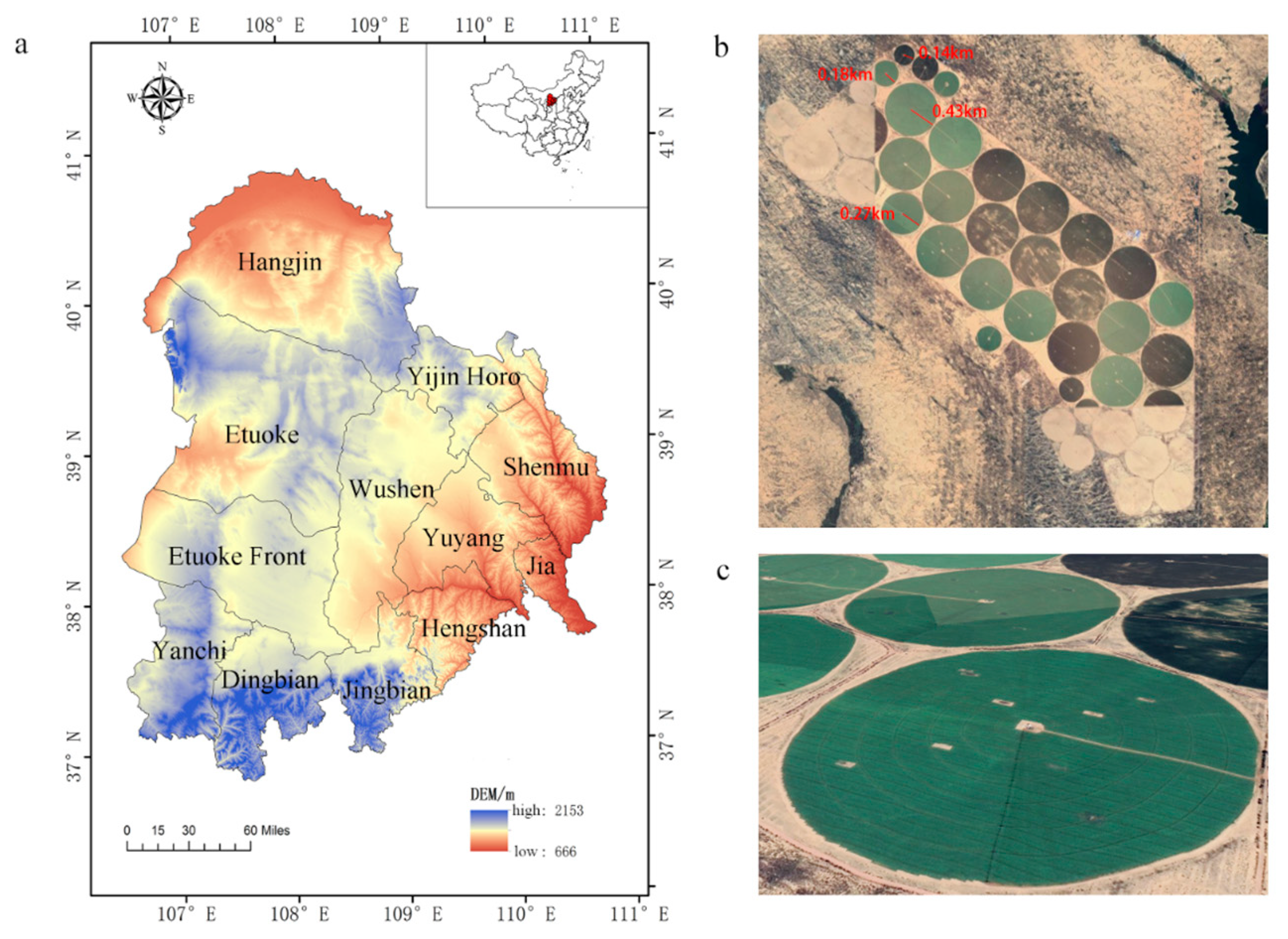
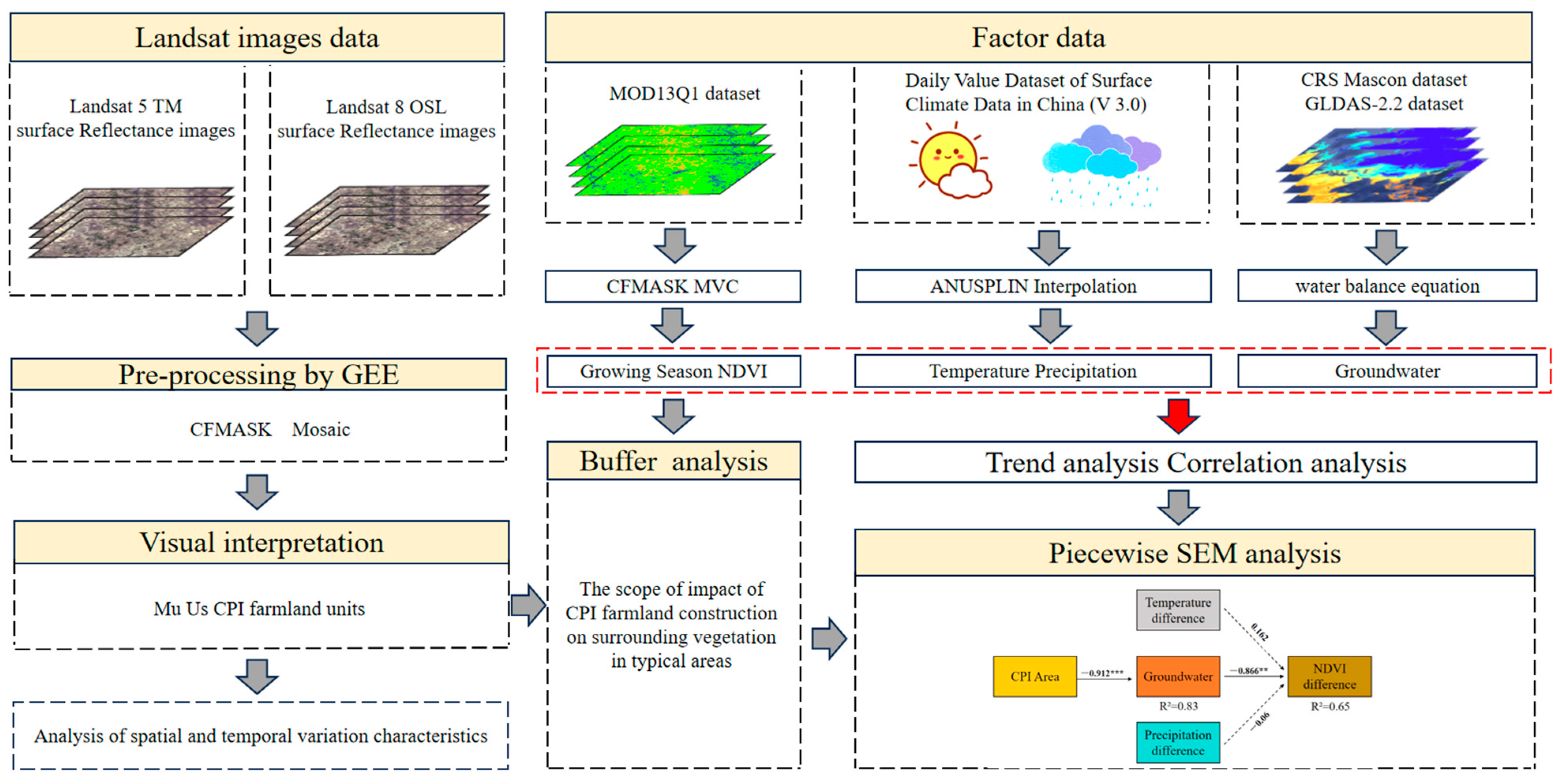
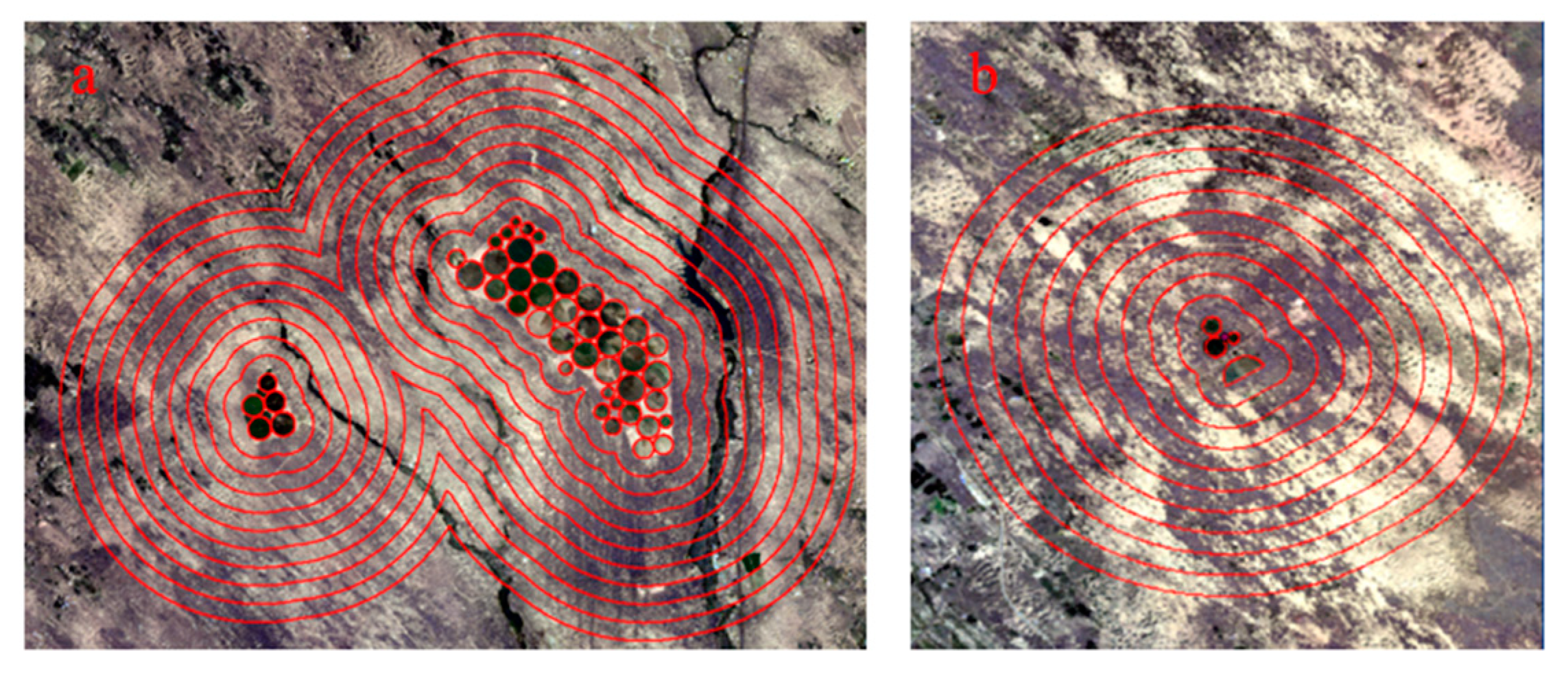
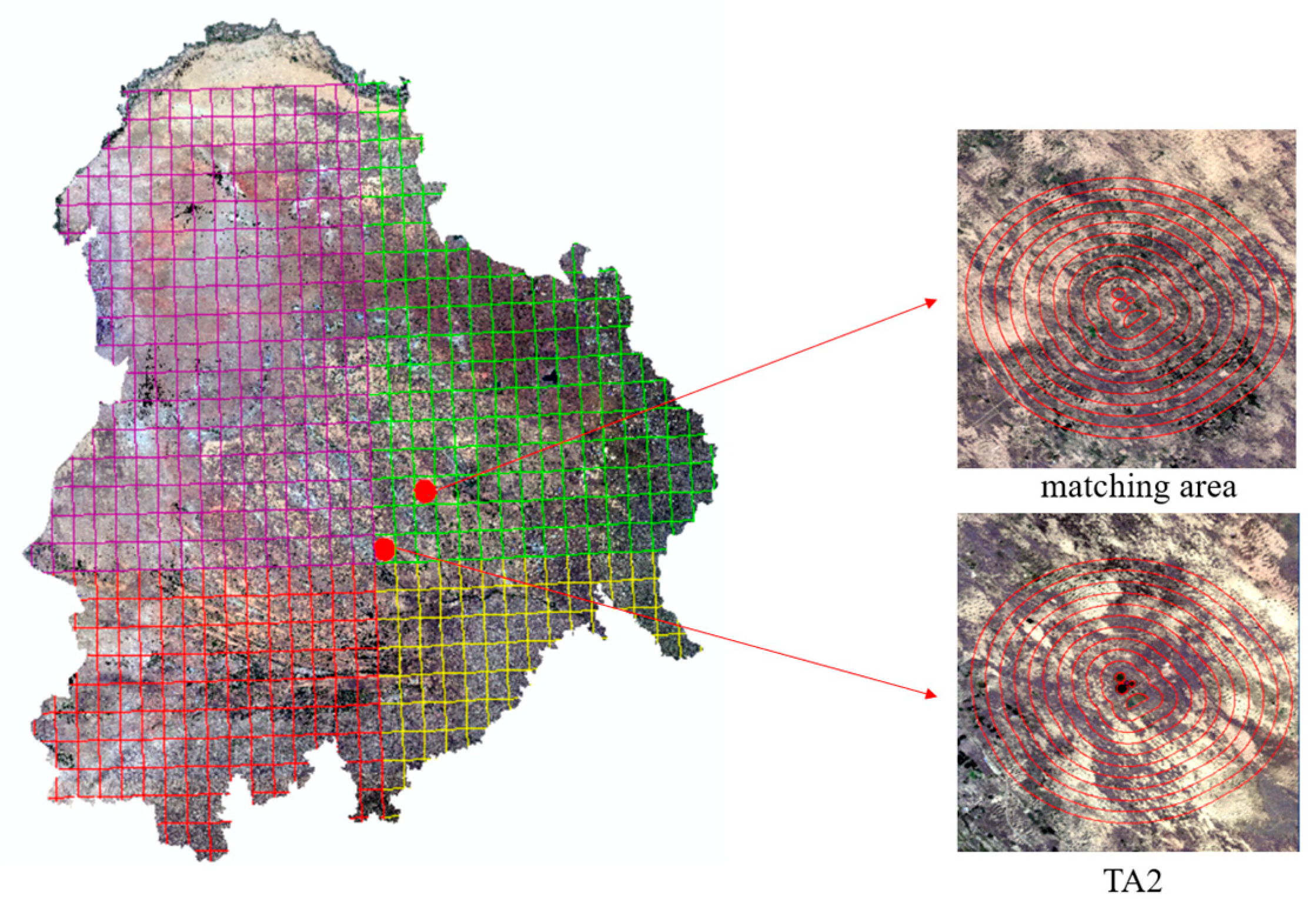
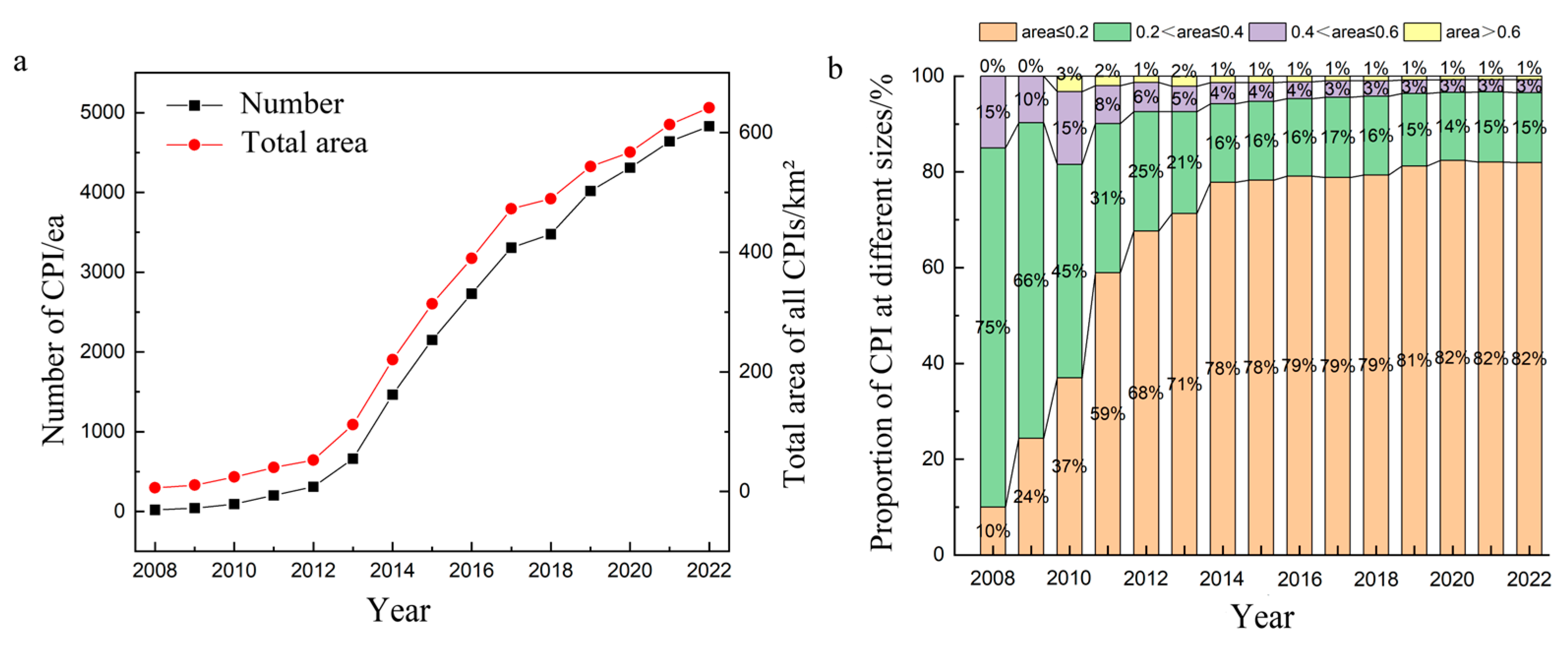
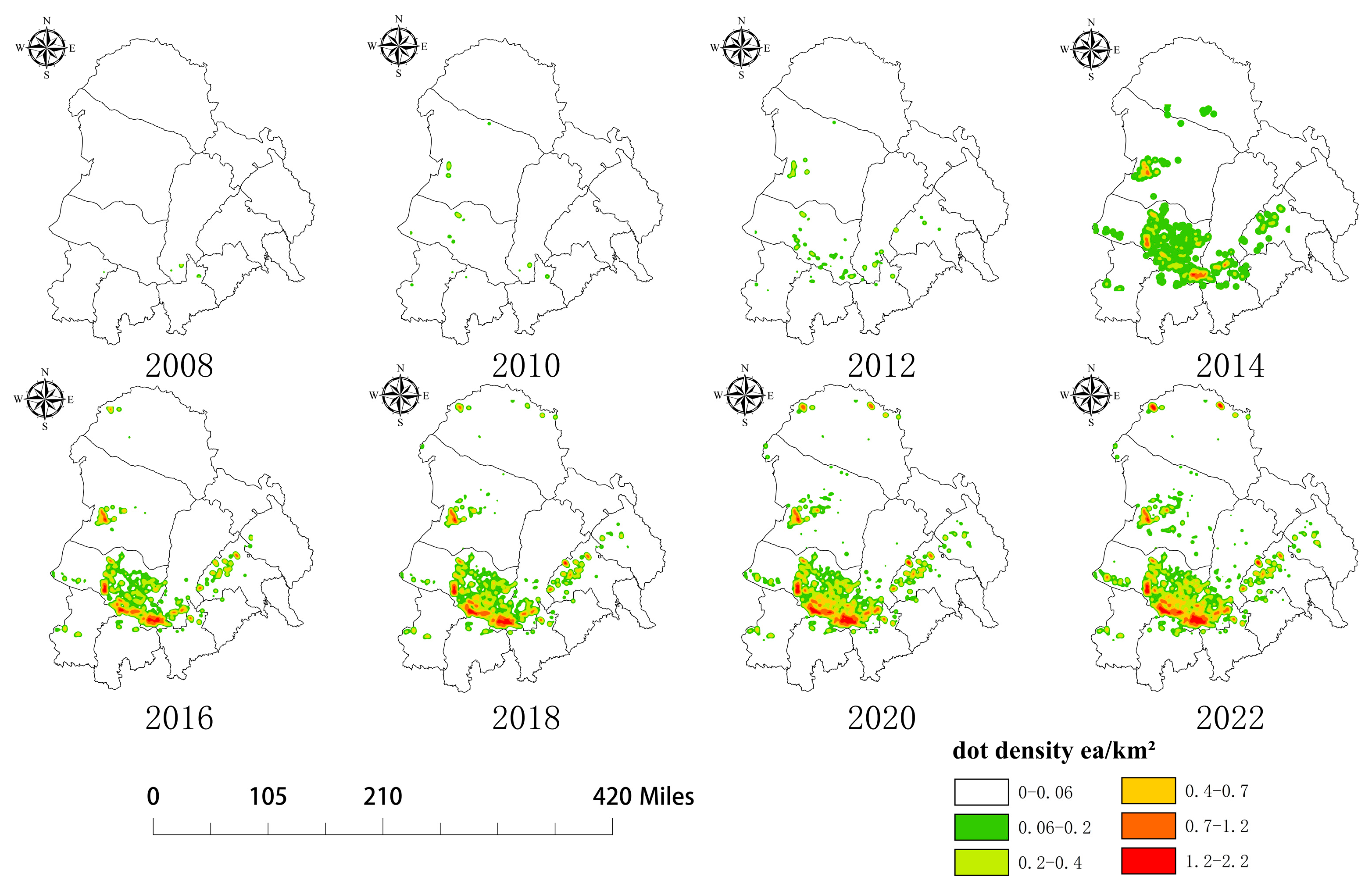
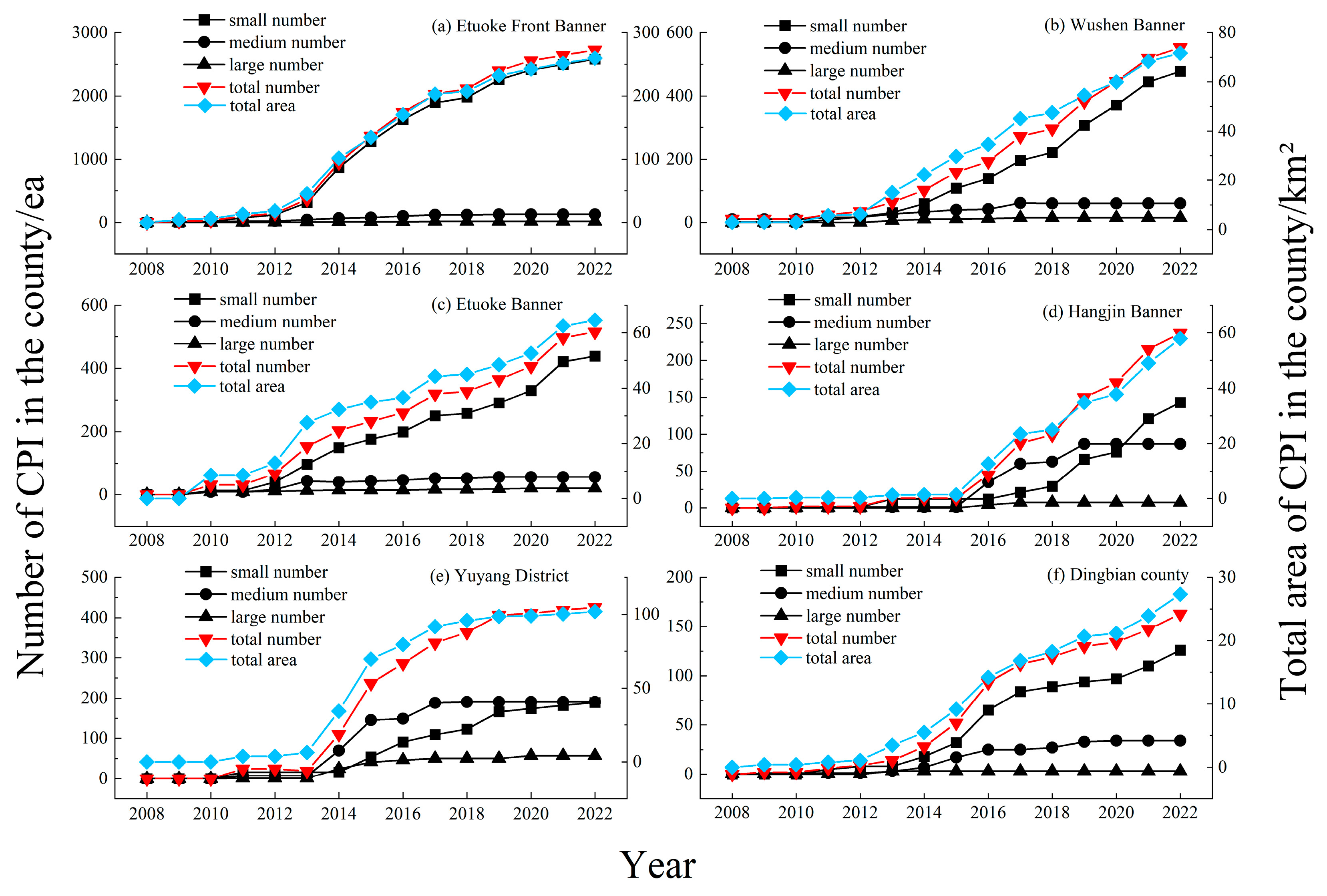

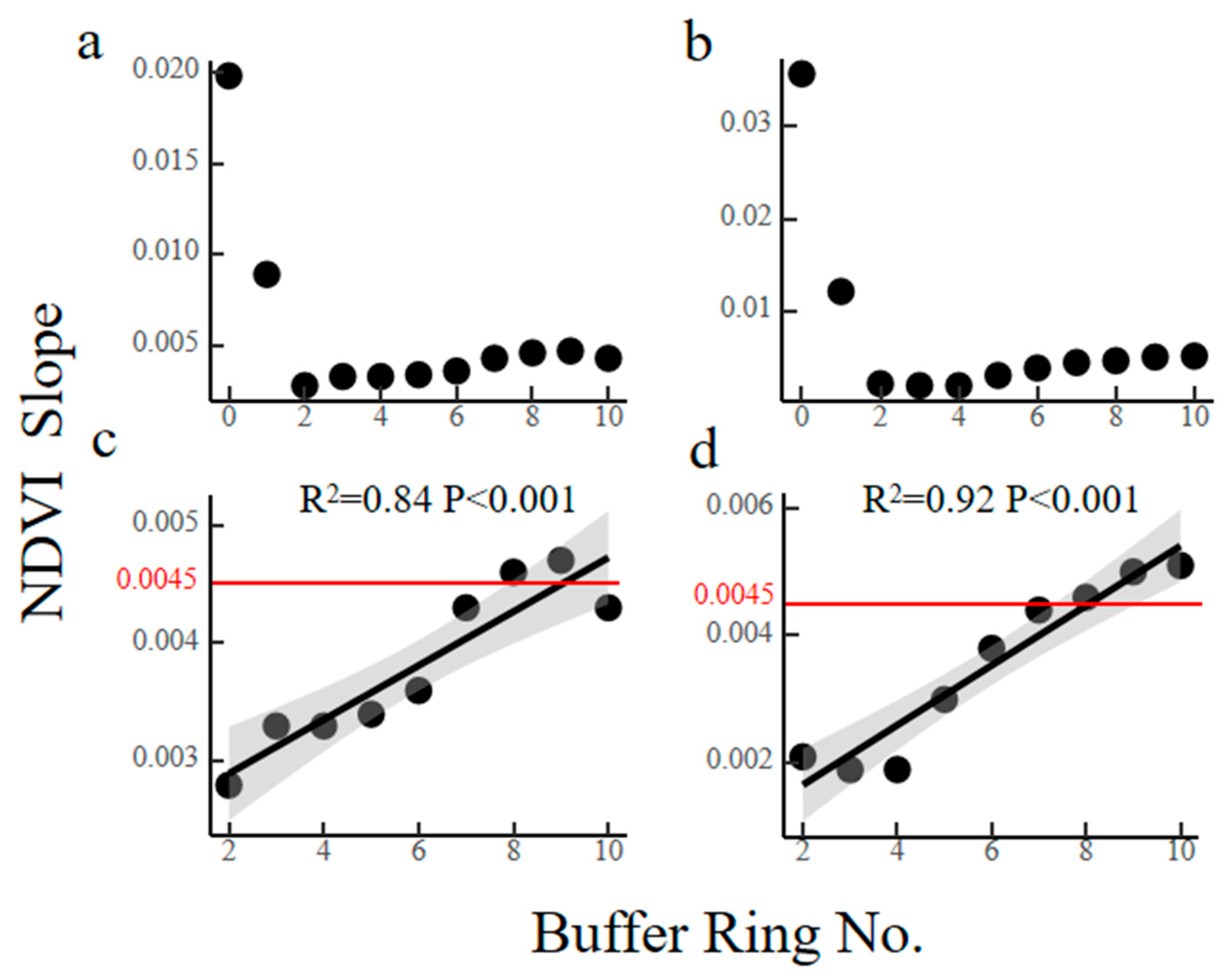
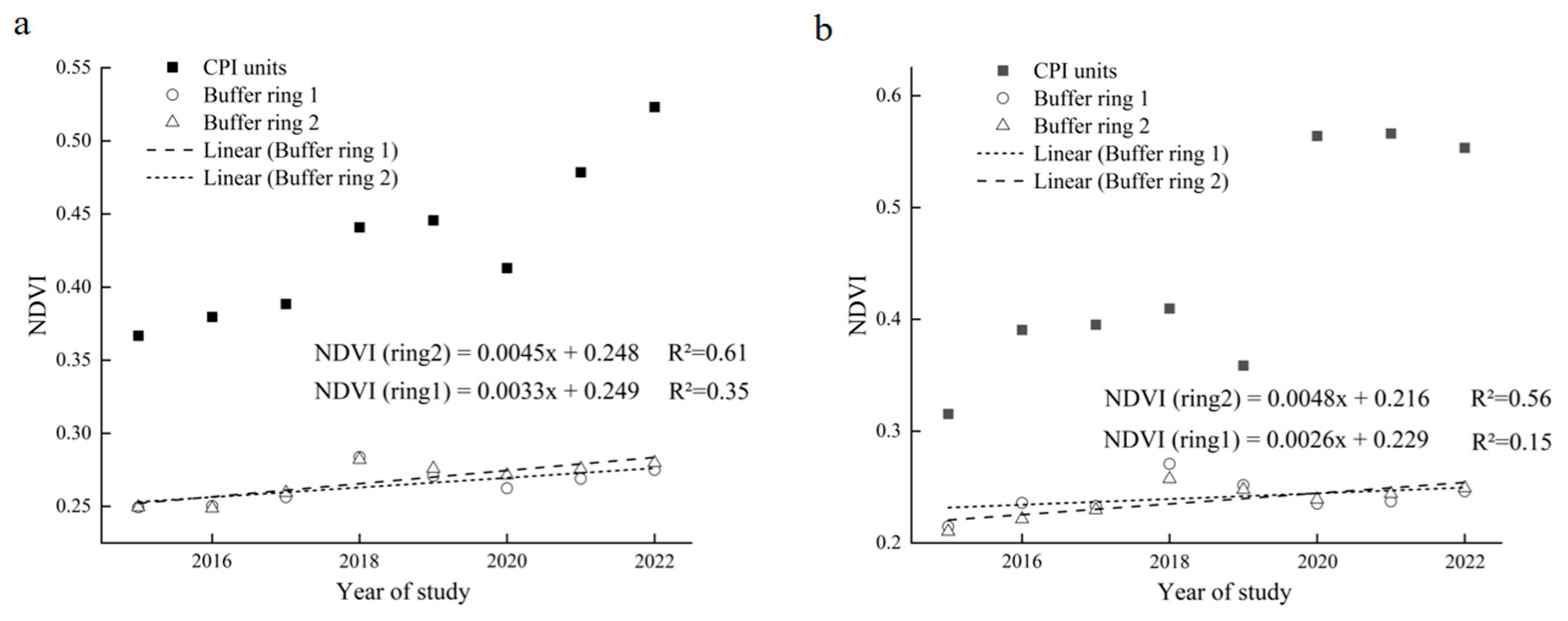
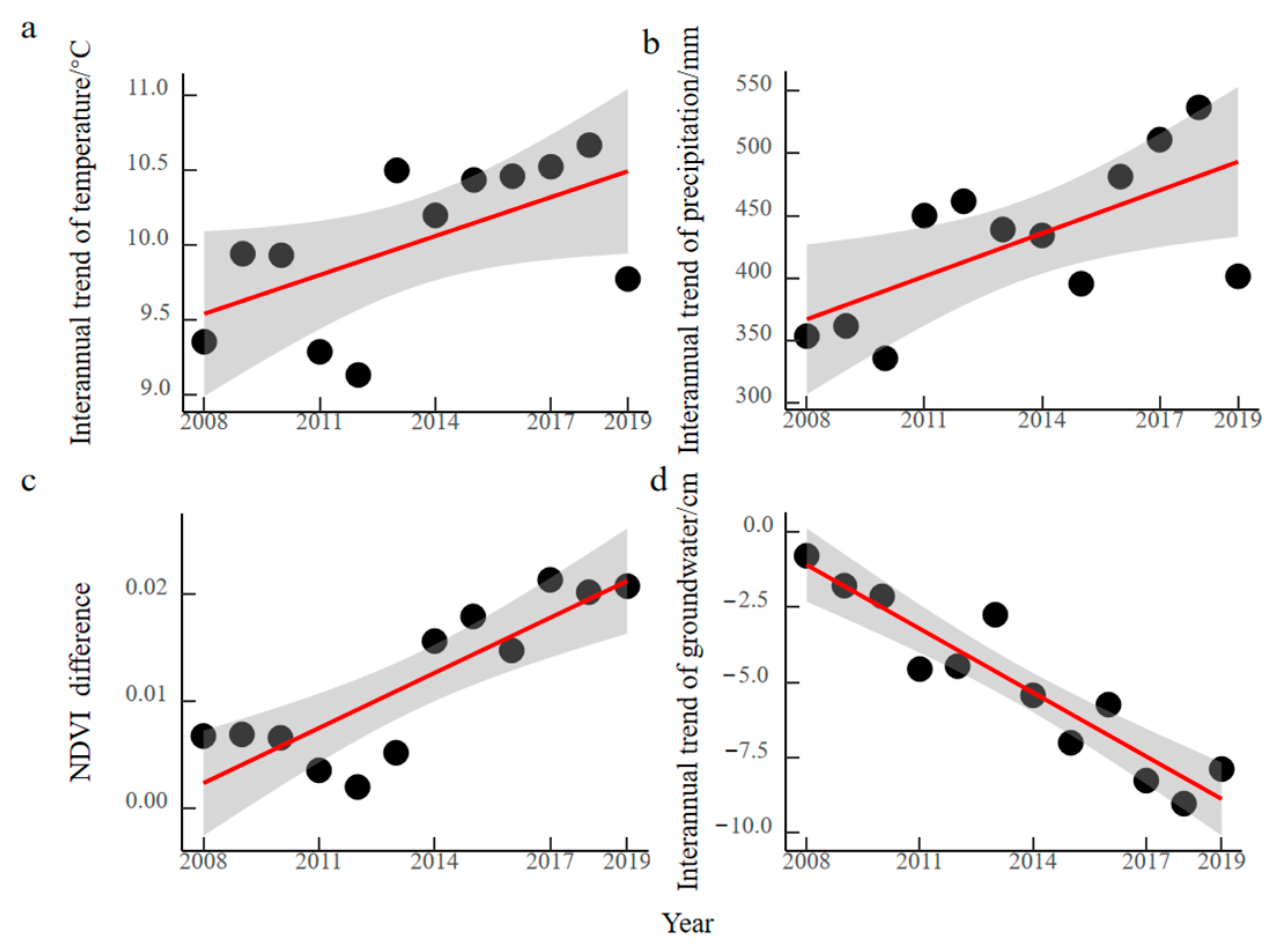
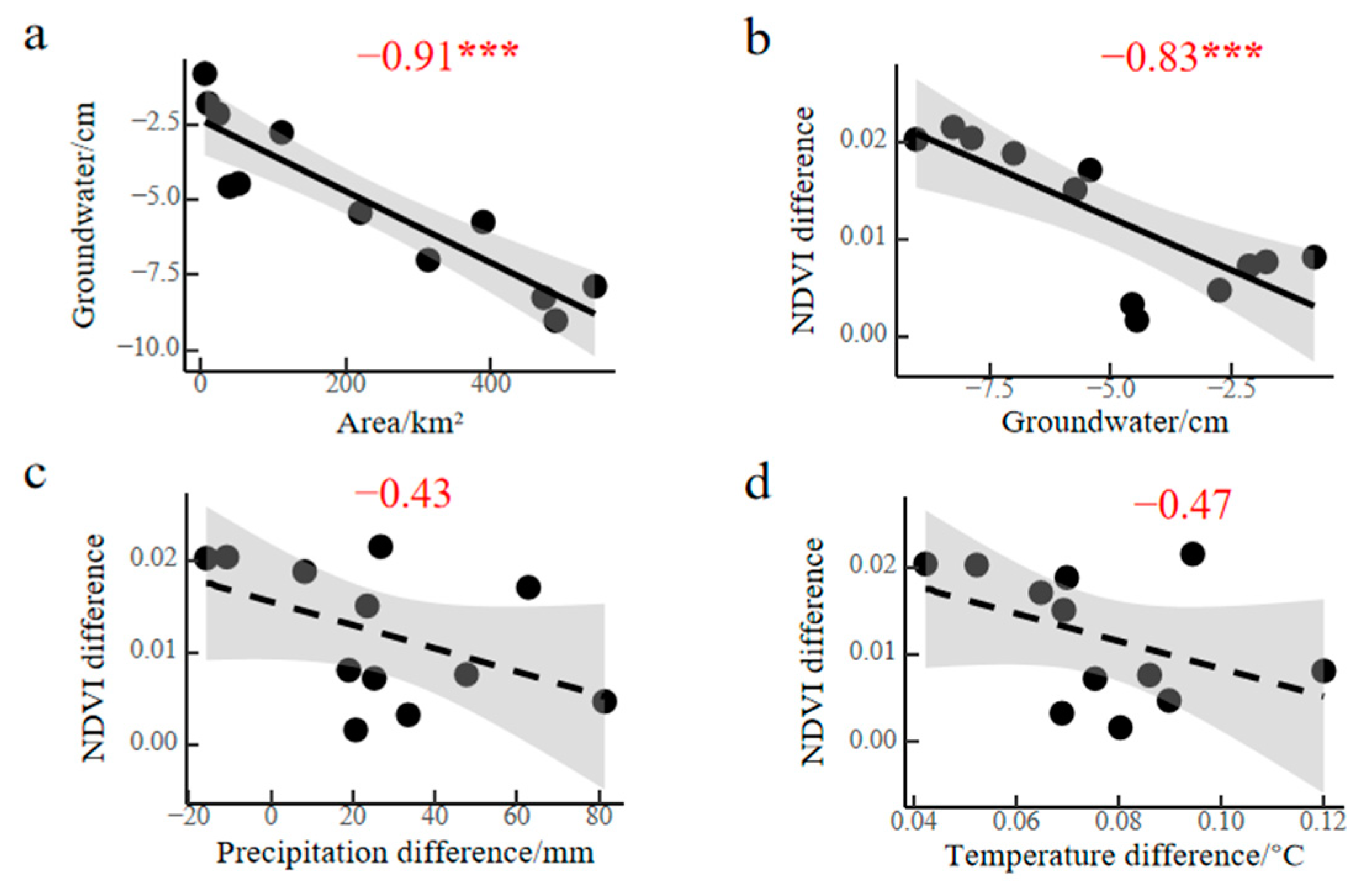


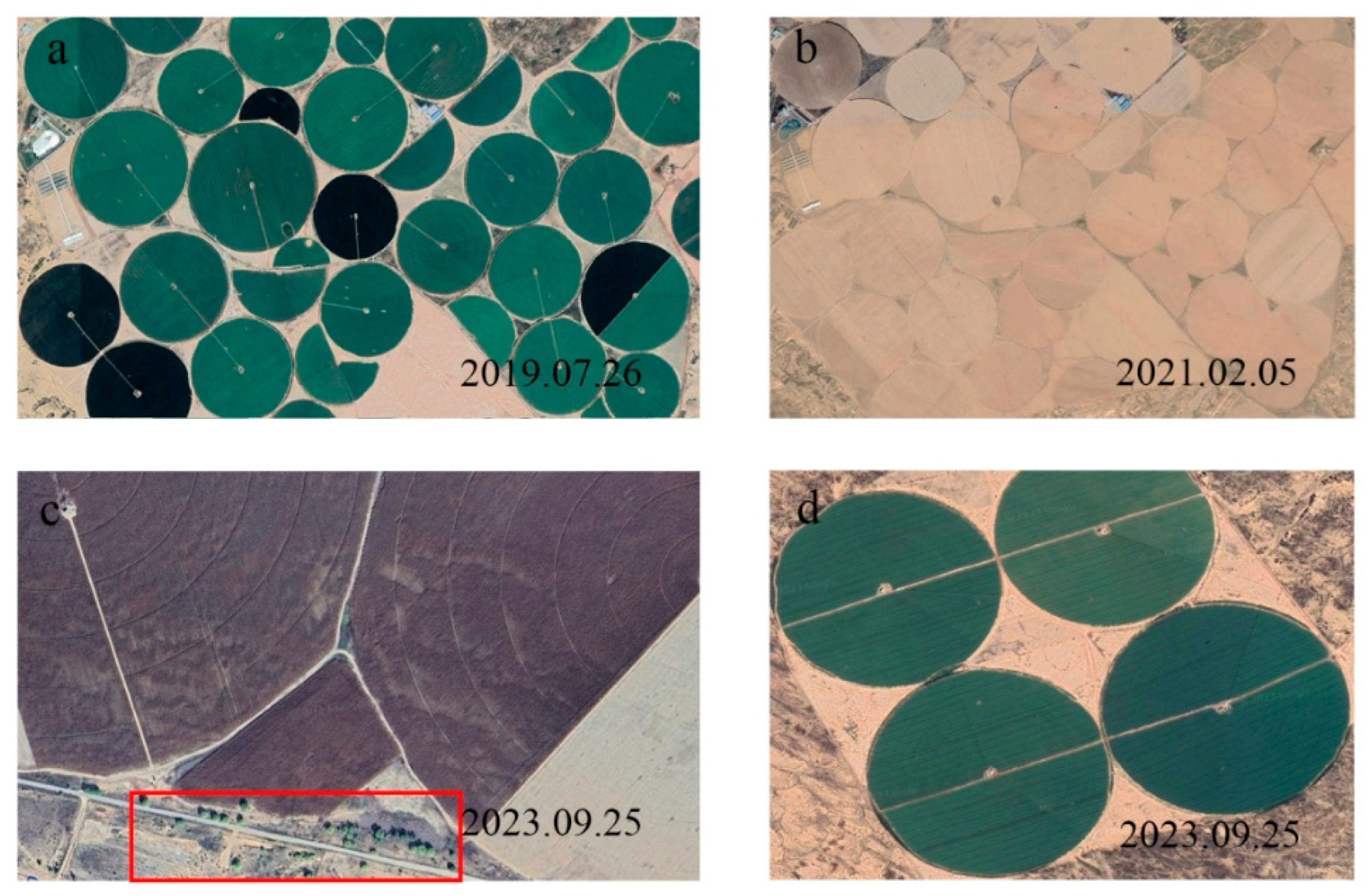
Disclaimer/Publisher’s Note: The statements, opinions and data contained in all publications are solely those of the individual author(s) and contributor(s) and not of MDPI and/or the editor(s). MDPI and/or the editor(s) disclaim responsibility for any injury to people or property resulting from any ideas, methods, instructions or products referred to in the content. |
© 2024 by the authors. Licensee MDPI, Basel, Switzerland. This article is an open access article distributed under the terms and conditions of the Creative Commons Attribution (CC BY) license (https://creativecommons.org/licenses/by/4.0/).
Share and Cite
Song, Z.; Du, J.; Li, L.; Zhu, X.; Chong, F.; Zhai, G.; Wu, L.; Chen, X.; Han, J. Spatiotemporal Changes of Center Pivot Irrigation Farmland in the Mu Us Region and Its Impact on the Surrounding Vegetation Growth. Remote Sens. 2024, 16, 569. https://doi.org/10.3390/rs16030569
Song Z, Du J, Li L, Zhu X, Chong F, Zhai G, Wu L, Chen X, Han J. Spatiotemporal Changes of Center Pivot Irrigation Farmland in the Mu Us Region and Its Impact on the Surrounding Vegetation Growth. Remote Sensing. 2024; 16(3):569. https://doi.org/10.3390/rs16030569
Chicago/Turabian StyleSong, Zebang, Jiaqiang Du, Lijuan Li, Xiaoqian Zhu, Fangfang Chong, Guangqing Zhai, Luyao Wu, Xiya Chen, and Jing Han. 2024. "Spatiotemporal Changes of Center Pivot Irrigation Farmland in the Mu Us Region and Its Impact on the Surrounding Vegetation Growth" Remote Sensing 16, no. 3: 569. https://doi.org/10.3390/rs16030569
APA StyleSong, Z., Du, J., Li, L., Zhu, X., Chong, F., Zhai, G., Wu, L., Chen, X., & Han, J. (2024). Spatiotemporal Changes of Center Pivot Irrigation Farmland in the Mu Us Region and Its Impact on the Surrounding Vegetation Growth. Remote Sensing, 16(3), 569. https://doi.org/10.3390/rs16030569






